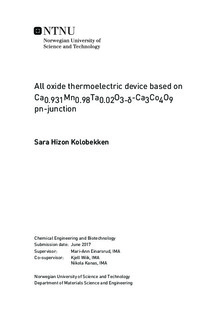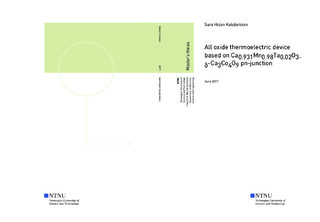| dc.description.abstract | Metal oxides are promising thermoelectric (TE) material candidates for TE modules operational in a range of 300-1200 K in air. In this work a TE oxide module was fabricated by co-sintering the p-type material Ca3Co4O9 (CCO), the n-type material Ca0.931Mn0.98Ta0.02O(3-δ) (CMTO) and the insulator material LaAlO3 (LAO) by the spark plasma sintering (SPS) method.
Nanosized spray pyrolysed powders of CCO, LAO and CMTO were spark plasma sintered (SPS) for 2 min at 880 °C. Sub-micrometer grain sizes were observed for the CMTO and LAO ceramics, and they reached a density of of 68 % and 41 % of the theoretical density respectively. The Ca3Co4O9-derived ceramic is a multi-phase composite due to partial decomposition of the starting powder during sintering. The ceramic reached a density of 96 % and had a grain size of ~1.2 μm. Increased residence time in the SPS showed little influence on the grain size.
By studying diffusion couples of two and two materials sintered in SPS at 850 °C, chemical interaction was evidenced by the formation of reaction layers at the different interfaces. The thickness of the layers varied in the range of 2 - 55 \si{\micro}m across the samples. Energy dispersive X-ray spectroscopy mapping in a scanning electron microscope (SEM) revealed that Ca3CoxMn(2-x)O6 was formed at the interface between CCO and CMTO, while decomposition of CCO resulted in a cobalt oxide layer the interface between CCO and LAO. Increased residence time did not appear to have a significant effect on the thickness of the formed layers, which is promising in terms of the rough conditions a TE device is subjected to during operation.
SEM investigations of TE couples sintered at a temperature of 880 °C revealed formation of micro cracks in the devices due to thermal expansion mismatch between the materials. The cracks are detrimental to the mechanical strength and stability of the device. The cracking was most prominent in the CMTO phase, and the correlation between CMTO thickness and tensile stresses in the sample was investigated through theoretic calculations. It was found that an increase in thickness caused a decrease in the stresses developed.
The TE device consisting of a single TE couple was characterized at two different temperatures and achieved a maximum electrical power output of 1.9 mW when the hot side temperature was 900 °C and a temperature difference of 130 °C was applied. | |

